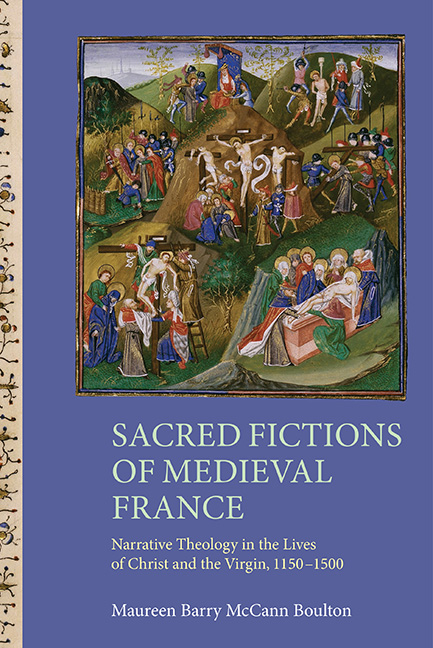 Sacred Fictions of Medieval France
Sacred Fictions of Medieval France Book contents
- Frontmatter
- Dedication
- Contents
- Acknowledgements
- Abbreviations
- Introduction
- 1 Sacred Romances: Genealogy, Lineage and Cyclicity
- 2 Sacred Epic and the Diffusion of Anti-Jewish Sentiment
- 3 Sacred Allegory and Meditation
- 4 Sacred Histories: the Chronicles of Jean d’Outremeuse and Jean Mansel
- 5 Sacred Imaginations: Lives of Christ and the Virgin in Texts of A ffective Devotion
- Epilogue: Lives and Afterlives
- Appendix: Lists of Manuscripts by Chapter
- Bibliography
- Index
3 - Sacred Allegory and Meditation
Published online by Cambridge University Press: 11 June 2021
- Frontmatter
- Dedication
- Contents
- Acknowledgements
- Abbreviations
- Introduction
- 1 Sacred Romances: Genealogy, Lineage and Cyclicity
- 2 Sacred Epic and the Diffusion of Anti-Jewish Sentiment
- 3 Sacred Allegory and Meditation
- 4 Sacred Histories: the Chronicles of Jean d’Outremeuse and Jean Mansel
- 5 Sacred Imaginations: Lives of Christ and the Virgin in Texts of A ffective Devotion
- Epilogue: Lives and Afterlives
- Appendix: Lists of Manuscripts by Chapter
- Bibliography
- Index
Summary
Par quoy pour a bon sens comprendre
Tout ce que ce livre contient
Moralement le fault entendre
Et non pas litteralement
Car l’acteur l’a fait cointement
Tenant forme parabolique
Pour aguiser l’entendement
A tout chascun scientifique.
(Prologue du Correcteur, Romant des trois pelerinages)[For this reason, in order to understand correctly everything that this book contains, it must be understood morally and not literally, for the author wrote it secretly, in the form of a parable, in order to sharpen the meaning in every science.]
Allegorical writing clearly fascinated medieval writers and readers, but modern critics have been slower to share their enthusiasm – to such an extent that Hans Robert Jauss opened his survey of medieval allegorical forms with an examination of critical dismissals of the genre. Since then, critics have increasingly come to appreciate allegorical writing, and particularly the sub-genre of the spiritual quest, which concerns us here. Inherent in the mode is a kind of double vision:
They [readers] are expected to see both the visionary world as it is seen by the stumbling narrator and the same world in its universal or spiritual significance.… Besides drawing the audience into the dramatic structure of the composition, the juxtaposition of the ‘I’ narrator and his dream world has an important thematic purpose. The conjunction of the concrete, naively literal narrator with an allegorical or symbolic vision provided an effective means for meshing time and eternity.
Because of the flexibility of the form, as well as its popularity with medieval audiences, several authors in different parts of the Francophone world employed a variety of allegorical techniques to recount part or all of the life of Christ between the second half of the thirteenth century and the end of the fifteenth century. The earliest of these is John of Howden, an English poet working the third quarter of the thirteenth century, who produced an extended allegorical meditation on the life, and especially the Passion of Christ, in the French of England. About a decade or so later, Matfre Ermengaud of Béziers in the Languedoc incorporated lives of Jesus and Mary into the allegorical system of his encyclopaedic Occitan Breviari d’amor, where they manifest the all-embracing love of God. In the middle of the next century, Guillaume de Digulleville (from the Cotentin in north-west Normandy) concluded his trilogy of allegorical pilgrimage poems with the Pelerinage Jhesucrist.
- Type
- Chapter
- Information
- Sacred Fictions of Medieval FranceNarrative Theology in the Lives of Christ and the Virgin, 1150–1500, pp. 141 - 190Publisher: Boydell & BrewerPrint publication year: 2015


